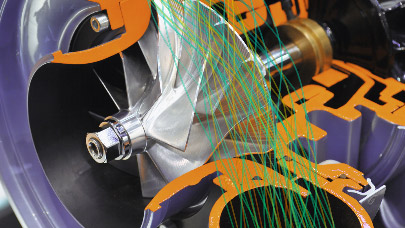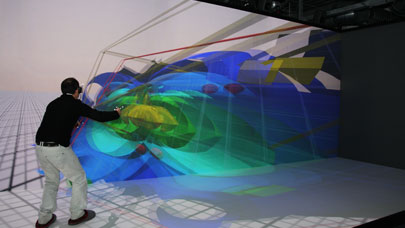Turbomachines may never be simple to optimize but decisive progress has recently been made in the ability to predict their efficiency. With the help of specialized simulation and modeling tools, turbomachinery engineers are now capable to improve every aspect of system performance.
Brad Hutchinson
Vice President of Industry Marketing, Turbomachinery, ANSYS Inc.
The turbo sector faces the pressing challenge of increasing the energy efficiency of not only the world’s more than 3 million major turbomachines but also all turbo-related equipment, whether it burns fuel directly (as in the case of gas turbines), whether energy is consumed in the process of driving the machines (as with industrial compressors), or whether it extracts energy from a flow stream (as for water turbines). It’s been proven that even fractional improvements in fuel performance yield substantial economic benefits. Experts estimate that just a 1 percent increase in fuel efficiency would deliver $30 billion in savings for the global commercial aviation industry over a 15-year horizon. The world’s gas-powered energy plants could realize a $66 billion financial benefit by achieving that same 1 percent improvement [1].
While efficiency is a huge concern, it is only one urgent priority on the agenda of the world’s turbomachinery engineers. Every day, they must balance concerns about operating efficiency or fuel economy with a range of other initiatives for cost and performance improvement. Energy efficiency initiatives are not only driven by cost, but also by environmental concerns, since reduced energy consumption generally relates to reduced carbon emissions (and it is one concrete way of measuring progress and compliance).
For example, according to the International Air Transport Association, in 2012 fuel costs accounted for approximately 33 percent of the overall expenses of the world’s airlines [2] – but the other 67 percent of costs relates to applications that could benefit from improvement as well. To succeed in an increasingly crowded global marketplace, airlines are driving costs out of every area of their operations, including aircraft maintenance. Every innovation that targets fuel efficiency – such as new composites materials that reduce weight – must meet a host of other performance criteria. They must be proven durable enough to also reduce lifetime maintenance and repair costs. And, of course, composites must demonstrate sufficient strength to ensure passenger safety under a full range of flight conditions.
Engineers of turbomachinery for automobiles, power plants and other applications face similar Catch-22 engineering challenges. While the universal mandate for increased efficiency receives an enormous amount of attention – as well as a large percentage of R&D dollars – the reality is that it is just one performance consideration. Optimizing reliability, safety, operating flexibility, noise, maintenance, environmental impact and time to market are other design pressures that turbo engineers feel acutely.
Because of ongoing demands to improve performance, turbomachinery engineers were among the first to embrace the power of engineering simulation. From the earliest days of simulation use in the sector, product developers recognized the power of building, testing and verifying their advanced systems in a cost-effective, low-risk virtual world. By identifying performance issues at an early stage, before making large investments of time and money in prototypes, turbomachinery engineers have made incredible strides in continually improving overall design robustness, along with introducing innovative performance features.
As product development teams in this segment face more intense pressures than ever before, engineering simulation has risen to the top of the list as a critical competency. Computer-aided design tools help to elucidate performance trade-offs at an incredible level of detail. Engineers can readily learn how their specific energy-efficiency initiatives such as increased combustion temperatures affect related performance features like materials strength and durability. By providing insight into these trade-offs, engineering simulation has supported the development of many important technology advancements in turbomachinery.
[1] Evans, P.C.; Annunziata, M. – Industrial Internet: Pushing the Boundaries of Minds and Machines, GE, November 26, 2012.
[2] Fact Sheet: Fuel.
More around this topic...
In the same section
© HPC Today 2024 - All rights reserved.
Thank you for reading HPC Today.





























